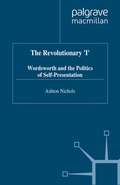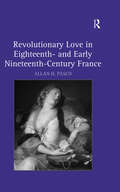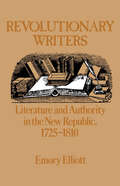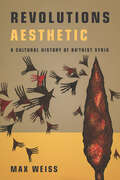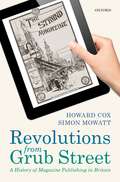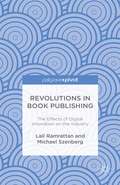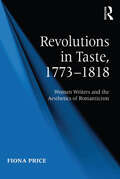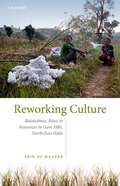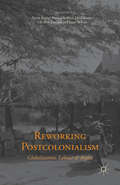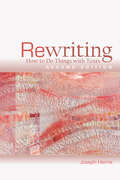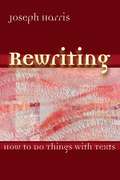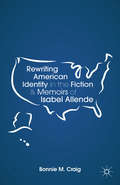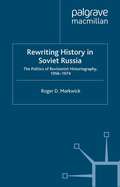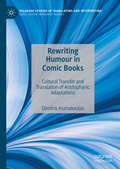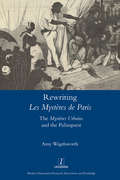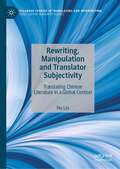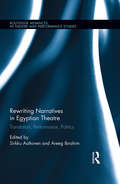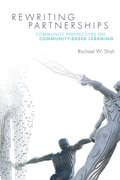- Table View
- List View
The Revolutionary 'I': Wordsworth and the Politics of Self-Presentation (Romanticism in Perspective:Texts, Cultures, Histories)
by A. NicholsIn the winter of 1798-99, shut up in the freezing German town of Goslar, William Wordsworth began producing a series of lyrical fragments that appeared first in letters written to Coleridge and emerged eventually as source texts for The Prelude . These lyrics are revolutionary because they construct a new version of the autobiographical 'I'. The Revolutionary 'I' explores the numerous voices of the poetic speaker 'Wordsworth' and their relationship to the historical figure who shared the same name.
Revolutionary Imaginings in the 1790s: Charlotte Smith, Mary Robinson, Elizabeth Inchbald
by A. GarnaiRevolutionary Imaginings in the 1790s discusses the work of three prominent women writers by focusing on the response to the French Revolution and the struggle for reform in Britain. Examining previously-neglected texts as well as more familiar ones, the book contributes to our understanding of a period of intense political and literary engagement.
Revolutionary Love in Eighteenth- and Early Nineteenth-Century France
by Allan H. PascoIn this innovative study, the author carves out a new field, a sociology of literature in which he offers insightful commentary about the nexus of literature and society. Calling on history, sociology, and psychology as well as literature as points of reference, Allan Pasco examines the conceptual shift in the ideal of love in eighteenth-century France. Pasco explores the radical, though gradual, changes that occurred during the Enlightenment with respect to how the emotion of love was viewed. Earlier, love had been subordinate to the demands of family, king, and deity; passion was dangerous, and to be avoided. But over time, individual happiness became the "greatest good," and passion the measure of love. Authors as diverse as Marivaux, Marmontel, Rousseau, Baculard d'Arnaud, Pigault-Lebrun and Madame de Staël make it clear that the ideal of rapturous love did not live up to its billing: it did not last, and it brought destructive fantasies, an epidemic of disease, the "scourge" of divorce, and considerable anguish. Still, as Pasco points out, passion became and remained the ideal, and the Romantics were left to plumb its nature.
Revolutionary Love in Eighteenth- and Early Nineteenth-Century France
by Allan H. PascoIn this innovative study, the author carves out a new field, a sociology of literature in which he offers insightful commentary about the nexus of literature and society. Calling on history, sociology, and psychology as well as literature as points of reference, Allan Pasco examines the conceptual shift in the ideal of love in eighteenth-century France. Pasco explores the radical, though gradual, changes that occurred during the Enlightenment with respect to how the emotion of love was viewed. Earlier, love had been subordinate to the demands of family, king, and deity; passion was dangerous, and to be avoided. But over time, individual happiness became the "greatest good," and passion the measure of love. Authors as diverse as Marivaux, Marmontel, Rousseau, Baculard d'Arnaud, Pigault-Lebrun and Madame de Staël make it clear that the ideal of rapturous love did not live up to its billing: it did not last, and it brought destructive fantasies, an epidemic of disease, the "scourge" of divorce, and considerable anguish. Still, as Pasco points out, passion became and remained the ideal, and the Romantics were left to plumb its nature.
Revolutionary Writers: Literature and Authority in the New Republic, 1725-1810
by Emory ElliottElliott demonstrates how America's first men of letters--Timothy Dwight, Joel Barlow, Philip Freneau, Hugh Henry Brackenridge, and Charles Brockden Brown--sought to make individual genius in literature express the collective genius of the American people. Without literary precedent to aid them, Elliott argues, these writers attempted to convey a vision of what America ought to be; and when the moral imperatives implicit in their writings were rejected by the vast number of their countrymen they became pioneers of another sort--the first to experience the alienation from mainstream American culture that would become the fate of nearly all serious writers who would follow.
Revolutions Aesthetic: A Cultural History of Ba'thist Syria (Stanford Studies in Middle Eastern and Islamic Societies and Cultures)
by Max WeissThe November 1970 coup that brought Hafiz al-Asad to power fundamentally transformed cultural production in Syria. A comprehensive intellectual, ideological, and political project—a Ba'thist cultural revolution—sought to align artistic endeavors with the ideological interests of the regime. The ensuing agonistic struggle pitted official aesthetics of power against alternative modes of creative expression that could evade or ignore the effects of the state. With this book, Max Weiss offers the first cultural and intellectual history of Ba'thist Syria, from the coming to power of Hafiz al-Asad, through the transitional period under Bashar al-Asad, and continuing up through the Syria War. Revolutions Aesthetic reconceptualizes contemporary Syrian politics, authoritarianism, and cultural life. Engaging rich original sources—novels, films, and cultural periodicals—Weiss highlights themes crucial to the making of contemporary Syria: heroism and leadership, gender and power, comedy and ideology, surveillance and the senses, witnessing and temporality, and death and the imagination. Revolutions Aesthetic places front and center the struggle around aesthetic ideology that has been key to the constitution of state, society, and culture in Syria over the course of the past fifty years.
Revolutions Aesthetic: A Cultural History of Ba'thist Syria (Stanford Studies in Middle Eastern and Islamic Societies and Cultures)
by Max WeissThe November 1970 coup that brought Hafiz al-Asad to power fundamentally transformed cultural production in Syria. A comprehensive intellectual, ideological, and political project—a Ba'thist cultural revolution—sought to align artistic endeavors with the ideological interests of the regime. The ensuing agonistic struggle pitted official aesthetics of power against alternative modes of creative expression that could evade or ignore the effects of the state. With this book, Max Weiss offers the first cultural and intellectual history of Ba'thist Syria, from the coming to power of Hafiz al-Asad, through the transitional period under Bashar al-Asad, and continuing up through the Syria War. Revolutions Aesthetic reconceptualizes contemporary Syrian politics, authoritarianism, and cultural life. Engaging rich original sources—novels, films, and cultural periodicals—Weiss highlights themes crucial to the making of contemporary Syria: heroism and leadership, gender and power, comedy and ideology, surveillance and the senses, witnessing and temporality, and death and the imagination. Revolutions Aesthetic places front and center the struggle around aesthetic ideology that has been key to the constitution of state, society, and culture in Syria over the course of the past fifty years.
Revolutions From Grub Street: A History Of Magazine Publishing In Britain
by Howard Cox Simon MowattRevolutions from Grub Street charts the evolution of Britain's popular magazine industry from its seventeenth century origins through to the modern digital age. Following the reforms engendered by the Glorious Revolution of 1688 the Grub Street area of London, which later transmuted into the cluster of venerable publishing houses centred on Fleet Street, spawned a vibrant culture of commercial writers and small-scale printing houses. Exploiting the commercial potential offered by improvements to the system of letterpress printing, and allied to a growing demand for popular forms of reading matter, during the course of the eighteenth century one of Britain's pioneering cultural industries began to take meaningful shape. Publishers of penny weeklies and sixpenny monthlies sought to capitalise on the opportunities that magazines, combining lively text with appealing illustrations, offered for the turning of a profit. The technological revolutions of the nineteenth century facilitated the emergence of a host of small and medium-sized printer-publishers whose magazine titles found a willing and growing audience ranging from Britain's semi-literate working classes through to its fashion-conscious ladies. In 1881, the launch of George Newnes' highly innovative Tit-Bits magazine created a publishing sensation, ushering in the era of the modern, million-selling popular weekly. Newnes and his early collaborators Arthur Pearson and Alfred Harmsworth, went on to create a group of competing business enterprises that, during the twentieth century, emerged as colossal publishing houses employing thousands of mainly trade union-regulated workers. In the early 1960s these firms, together with Odhams Press, merged to create the basis of the modern magazine giant IPC. Practically a monopoly producer until the 1980s, IPC was convulsed thereafter by the dual revolutions of globalization and digitization, finding its magazines under commercial attack from all directions. Challenged first by EMAP, Natmags, and Condé Nast, by the 1990s IPC faced competition both from expanding European rivals, such as H. Bauer, and a variety of newly-formed agile domestic competitors who were able to successfully exploit the opportunities presented by desktop publishing and the world wide web. In a narrative spanning over 300 years, Revolutions from Grub Street draws together a wide range of new and existing sources to provide the first comprehensive business history of magazine-making in Britain.
Revolutions in Book Publishing: The Effects of Digital Innovation on the Industry
by Michael Szenberg Lall RamrattanRevolutions in Book Publishing uses dynamic methods to examine the evolution of the industry's transition from physical place to cyber space, analyzing the latest effects of technological innovations on the industry as well as their influence on distribution channels, market structure, and conduct of the industry.
Revolutions in Taste, 1773–1818: Women Writers and the Aesthetics of Romanticism
by Fiona PriceHow and to what extent did women writers shape and inform the aesthetics of Romanticism? Were undervalued genres such as the romance, gothic fiction, the tale, and the sentimental and philosophical novel part of a revolution leading to newer, more democratic models of taste? Fiona Price takes up these important questions in her wide-ranging study of women's prose writing during an extended Romantic period. While she offers a re-evaluation of major women writers such as Mary Wollstonecraft, Maria Edgeworth, Ann Radcliffe and Charlotte Smith, Price also places emphasis on less well-known figures, including Joanna Baillie, Anna Letitia Barbauld, Elizabeth Hamilton and Priscilla Wakefield. The revolution in taste occasioned by their writing, she argues, was not only aesthetic but, following in the wake of British debates on the French Revolution, politically charged. Her book departs from previous studies of aesthetics that emphasize the differences between male and female writers or focus on higher status literary forms such as the treatise. In demonstrating that women writers' discussion of taste can be understood as an intervention at the most fundamental level of political involvement, Price advances our understanding of Romantic aesthetics.
Revolutions in Taste, 1773–1818: Women Writers and the Aesthetics of Romanticism
by Fiona PriceHow and to what extent did women writers shape and inform the aesthetics of Romanticism? Were undervalued genres such as the romance, gothic fiction, the tale, and the sentimental and philosophical novel part of a revolution leading to newer, more democratic models of taste? Fiona Price takes up these important questions in her wide-ranging study of women's prose writing during an extended Romantic period. While she offers a re-evaluation of major women writers such as Mary Wollstonecraft, Maria Edgeworth, Ann Radcliffe and Charlotte Smith, Price also places emphasis on less well-known figures, including Joanna Baillie, Anna Letitia Barbauld, Elizabeth Hamilton and Priscilla Wakefield. The revolution in taste occasioned by their writing, she argues, was not only aesthetic but, following in the wake of British debates on the French Revolution, politically charged. Her book departs from previous studies of aesthetics that emphasize the differences between male and female writers or focus on higher status literary forms such as the treatise. In demonstrating that women writers' discussion of taste can be understood as an intervention at the most fundamental level of political involvement, Price advances our understanding of Romantic aesthetics.
Reworking Culture: OK
by Erik de MaakerReworking Culture: Relatedness, Rites, and Resources in Garo Hills, North-East India provides intimate insights into the lives of Garo hill farmers, and the challenges they face in day-to-day life. Focusing on the ongoing reinterpretation of traditions, or customs, the book reveals the inadequacy of the all too often assumed characterization of upland societies as culturally homogenous, internally cohesive, and unchanging. Based on extensive ethnographic fieldwork, the book focuses on a rural area where land constitutes the most important resource, and where a substantial number of people practise traditional Garo animism. The book explores how people create and continually reinterpret the multiple relationships that connect them as a community, to the spirits, and to the land. These relationships are embedded in normative frameworks that call for compliance, yet leave room for ambiguity and negotiation. Far from being immutable, these need to be constantly expressed, (re-)interpreted, and enacted. The book thus shows how Garo traditions, referred to as niam, are continuously revised and reworked in response to new economic and political opportunities, as well as to changes in the ontological landscape.
Reworking Postcolonialism: Globalization, Labour and Rights
by Janet Wilson Birte Heidemann Pavan Kumar Malreddy Ole Birk LaursenAn interdisciplinary collection of essays, Reworking Postcolonialism explores questions of work, precarity, migration, minority and indigenous rights in relation to contemporary globalization. It brings together political, economic and literary approaches to texts and events from across the postcolonial world.
Rewriting: How to Do Things with Texts, Second Edition
by Joseph Harris“Like all writers, intellectuals need to say something new and say it well. But for intellectuals, unlike many other writers, what we have to say is bound up with the books we are reading . . . and the ideas of the people we are talking with.” What are the moves that an academic writer makes? How does writing as an intellectual change the way we work from sources? In Rewriting, Joseph Harris draws the college writing student away from static ideas of thesis, support, and structure, and toward a more mature and dynamic understanding. Harris wants college writers to think of intellectual writing as an adaptive and social activity, and he offers them a clear set of strategies—a set of moves—for participating in it. The second edition introduces remixing as an additional signature move and is updated with new attention to digital writing, which both extends and rethinks the ideas of earlier chapters.
Rewriting: How To Do Things With Texts
by Joseph Harris"Like all writers, intellectuals need to say something new and say it well. But unlike many other writers, what intellectuals have to say is bound up with the books we are reading . . . and the ideas of the people we are talking with." What are the moves that an academic writer makes? How does writing as an intellectual change the way we work from sources? In Rewriting, a textbook for the undergraduate classroom, Joseph Harris draws the college writing student away from static ideas of thesis, support, and structure, and toward a more mature and dynamic understanding. Harris wants college writers to think of intellectual writing as an adaptive and social activity, and he offers them a clear set of strategies—a set of moves—for participating in it.
Rewriting American Identity in the Fiction and Memoirs of Isabel Allende
by B. CraigMoving away from territorially-bound narratives toward a more kinetic conceptualization of identity, this book represents the first analysis of the politics of American identity within the fiction and memoirs of Isabel Allende. Craig offers a radical transformation of societal frameworks through revised notions of place, temporality, and space.
Rewriting History in Soviet Russia: The Politics of Revisionist Historiography 1956–1974
by R. MarkwickThis book explores the political significance of the development of historical revisionism in the USSR under Khrushchev in the wake of the Twentieth Congress of the CPSU and its demise with the onset of the 'period of stagnation' under Brezhnev. On the basis of intensive interviews and original manuscript material, the book demonstrates that the vigorous rejuvenation of historiography undertaken by Soviet historians in the 1960s conceptually cleared the way for and fomented the dramatic upheaval in Soviet historical writing occasioned by the advent of perestroika.
Rewriting Humour in Comic Books: Cultural Transfer and Translation of Aristophanic Adaptations (Palgrave Studies in Translating and Interpreting)
by Dimitris AsimakoulasThis book examines comic book adaptations of Aristophanes’ plays in order to shed light on how and why humour travels across cultures and time. Forging links between modern languages, translation and the study of comics, it analyses the Greek originals and their English translations and offers a unique, language-led research agenda for cultural flows, and the systematic analysis of textual norms in a multimodal environment. It will appeal to students and scholars of Modern Languages, Translation Studies, Comics Studies, Cultural Studies and Comparative Literature.
Rewriting 'Les Mystères de Paris': The 'Mystères Urbains' and the Palimpsest (Legenda)
by Amy WigelsworthKey works of popular fiction are often rewritten to capitalize on their success. But what are the implications of this rewriting process? Such is the question addressed by this detailed study of several rewritings of Eugène Sue’s Mystères de Paris (1842-43), produced in the latter half of the nineteenth century, in response to the phenomenal success of Sue’s archetypal urban mystery. Pursuing a compelling analogy between city and text, and exploring the resonance of the palimpsest trope to both, Amy Wigelsworth argues that the mystères urbains are exemplary rewritings, which shed new light on contemporary reading and writing practices, and emerge as early avatars of a genre still widely consumed and enjoyed in the 21st century.
Rewriting 'Les Mystères de Paris': The 'Mystères Urbains' and the Palimpsest (Legenda)
by Amy WigelsworthKey works of popular fiction are often rewritten to capitalize on their success. But what are the implications of this rewriting process? Such is the question addressed by this detailed study of several rewritings of Eugène Sue’s Mystères de Paris (1842-43), produced in the latter half of the nineteenth century, in response to the phenomenal success of Sue’s archetypal urban mystery. Pursuing a compelling analogy between city and text, and exploring the resonance of the palimpsest trope to both, Amy Wigelsworth argues that the mystères urbains are exemplary rewritings, which shed new light on contemporary reading and writing practices, and emerge as early avatars of a genre still widely consumed and enjoyed in the 21st century.
Rewriting, Manipulation and Translator Subjectivity: Translating Chinese Literature in a Global Context (Palgrave Studies in Translating and Interpreting)
by Hu LiuThis book presents an in-depth analysis of Howard Goldblatt’s translation of Mo Yan’s Life and Death Are Wearing Me Out (L&D). It explores how Goldblatt translates the original novel under the influence of three major manipulative powers: poetics, ideology and patronage, as well as his own subjectivity (translator subjectivity), to achieve his objectives as a literary translator. The author analyses both the translation and its paratext to gain a more complete understanding of Goldblatt’s accomplishments, and examines how Goldblatt rewrites the original text under the influence of various patronage factors, such as the original author, publisher, editor, market expectancy, literary collaborator, and the target reader. This book provides a comprehensive picture of the production, reception and dissemination of Goldblatt’s translation, exposing the motivations behind his translation in full measure, and it will be of interest to students and scholars of Translation Studies, Comparative Literature and Literary Studies, and Chinese Culture and Literature.
Rewriting Narratives in Egyptian Theatre: Translation, Performance, Politics (Routledge Advances in Theatre & Performance Studies)
by Sirkku Aaltonen Areeg IbrahimThis study of Egyptian theatre and its narrative construction explores the ways representations of Egypt are created of and within theatrical means, from the 19th century to the present day. Essays address the narratives that structure theatrical, textual, and performative representations and the ways the rewriting process has varied in different contexts and at different times. Drawing on concepts from Theatre and Performance Studies, Translation Studies, Cultural Studies, Postcolonial Studies, and Diaspora Studies, scholars and practitioners from Egypt and the West enter into dialogue with one another, expanding understanding of the different fields. The articles focus on the ways theatre texts and performances change (are rewritten) when crossing borders between different worlds. The concept of rewriting is seen to include translation, transformation, and reconstruction, and the different borders may be cultural and national, between languages and dramaturgies, or borders that are present in people’s everyday lives. Essays consider how rewritings and performances cross borders from one culture, nation, country, and language to another. They also study the process of rewriting, the resulting representations of foreign plays on stage, and representations of the Egyptian revolution on stage and in Tahrir Square. This assessment of the relationship between theatre practices, exchanges, and rewritings in Egyptian theatre brings vital coverage to an undervisited area and will be of interest to developments in theatre translation and beyond.
Rewriting Narratives in Egyptian Theatre: Translation, Performance, Politics (Routledge Advances in Theatre & Performance Studies)
by Sirkku Aaltonen Areeg IbrahimThis study of Egyptian theatre and its narrative construction explores the ways representations of Egypt are created of and within theatrical means, from the 19th century to the present day. Essays address the narratives that structure theatrical, textual, and performative representations and the ways the rewriting process has varied in different contexts and at different times. Drawing on concepts from Theatre and Performance Studies, Translation Studies, Cultural Studies, Postcolonial Studies, and Diaspora Studies, scholars and practitioners from Egypt and the West enter into dialogue with one another, expanding understanding of the different fields. The articles focus on the ways theatre texts and performances change (are rewritten) when crossing borders between different worlds. The concept of rewriting is seen to include translation, transformation, and reconstruction, and the different borders may be cultural and national, between languages and dramaturgies, or borders that are present in people’s everyday lives. Essays consider how rewritings and performances cross borders from one culture, nation, country, and language to another. They also study the process of rewriting, the resulting representations of foreign plays on stage, and representations of the Egyptian revolution on stage and in Tahrir Square. This assessment of the relationship between theatre practices, exchanges, and rewritings in Egyptian theatre brings vital coverage to an undervisited area and will be of interest to developments in theatre translation and beyond.
Rewriting Partnerships: Community Perspectives on Community-Based Learning
by Rachael W. ShahCommunity members are rarely tapped for their insights on engaged teaching and research, but without these perspectives, it is difficult to create ethical and effective practices. Rewriting Partnerships calls for a radical reorientation to the knowledges of community partners. Emphasizing the voices of community members themselves—the adult literacy learners, secondary students, and youth activists who work with college students—the book introduces Critical Community-Based Epistemologies, a deeply practical approach to knowledge construction that centers the perspectives of marginalized participants. Drawing on interviews with over eighty community members, Rewriting Partnerships features community knowledges in three common types of community-engaged learning: youth working with college students in a writing exchange program, nonprofit staff who serve as clients for student projects, and community members who work with graduate students. Interviewees from each type of partnership offer practical strategies for creating more ethical collaborations, including how programs are built, how projects are introduced to partners, and how graduate students are educated. The book also explores three approaches to partnership design that create space for community voices at the structural level: advisory boards, participatory evaluation, and community grading. Immediately applicable to teachers, researchers, community partners, and administrators involved in community engagement, Rewriting Partnerships offers concrete strategies for creating more community-responsive partnerships at the classroom level as well as at the level of program and research design. But most provocatively, the book challenges common assumptions about who can create knowledge about community-based learning, demonstrating that community partners have the potential to contribute significantly to community engagement scholarship and program decision-making.
